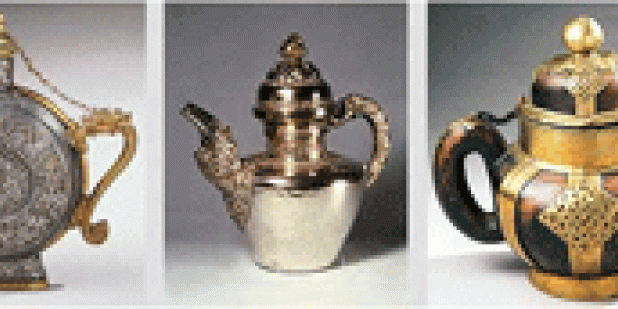Happy Lunar New Year from the USC US-China Institute!
Pots of Silver and Gold
The Newark Museum hosts an exhibition of Tibetan and Mongolian tea and beer pitchers.
Where

Overview
The distinctive silhouettes of Tibetan and Mongolian tea and beer pitchers—richly decorated with silver and gold—are replete with layers of auspicious symbols, used to imbibe a variety of drink and food and are made using a range of techniques.
Symbolic Motifs
Topped with lotus buds and ringed with lotus petals—symbols of untainted purity—other decorative motifs appearing on many Tibetan teapots and beer pitchers include makara spouts and dragon handles. A makara is a mythical animal that is a hybrid of a crocodile and an elephant. Popular throughout many parts of Asia, the lotus, makara and dragon are symbols of celestial, life-giving waters and thus are particularly appropriate for drinking vessels.
Some teapots include the Chinese character shou, indicating longevity. Others display a kirtimukha ‘face-of-glory’ (another celestial beneficent motif) or the eight auspicious symbols: the parasol, two fish, lotus, endless knot, wheel, victory-banner, conch shell and vase.
Feasting
Popular Tibetan drinks include barley beer (chang), sweet milk tea (gSol ja), butter tea (bod ja) and—in Mongolia especially—fermented mare’s milk (airag). Butter tea must be drunk warm. Cup-covers both keep in warmth and provide an excuse for luxurious ornamentation. One staple of the Tibetan diet is barley flour (tsampa) which each individual mixes in their own cup with the butter tea to form tasty dough ball—literally the bread and butter of Tibet.
Fabrication Techniques
Repoussé
Many Tibetan teapots and pitchers are created by hammering sheets of metal into the desired forms. Known as repoussé, this technique can produce very smooth surfaces as well as raised relief and pierced openwork.
Damascene
Some pitchers are made by hammering softer metals, such as gold and silver, into harder metals like iron. One name for this inlaid metal procedure is damascene—named for the city of Damascus, which was once renowned for this technique.
Wood-turning
Wood-carvers shaped some vessels by turning a lathe to hollow out wooden cups and pitchers from wood burls. Metal-workers then decorated these turned wooden pieces with metal appliqués.
Featured Articles
We note the passing of many prominent individuals who played some role in U.S.-China affairs, whether in politics, economics or in helping people in one place understand the other.
Events
Ying Zhu looks at new developments for Chinese and global streaming services.
David Zweig examines China's talent recruitment efforts, particularly towards those scientists and engineers who left China for further study. U.S. universities, labs and companies have long brought in talent from China. Are such people still welcome?






